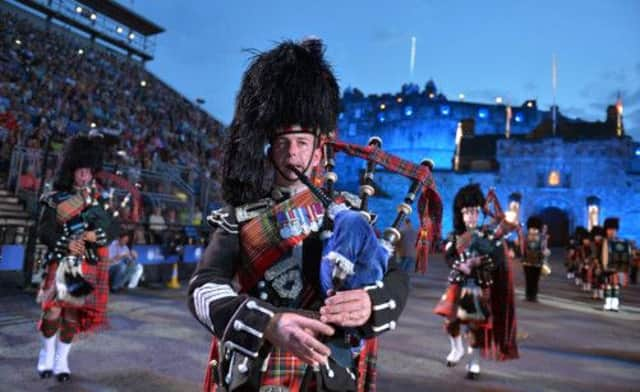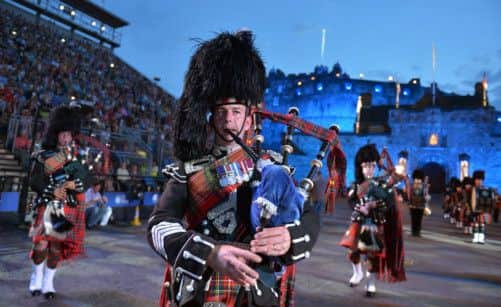A guide to the Edinburgh Royal Military Tattoo


It’s not as if the Tattoo goes out of its way to fall under the radar, either. Held atop one of the city’s highest points at Edinburgh Castle, the tattoo is a firework display given flesh.
Highland dancers, massed bands, Scottish army regiments, display teams and other acts from all across the world gather before around an accumulative total of 217,000 visitors every year to soak in an atmosphere unique to the city.
What is the Tattoo?
Advertisement
Hide AdAdvertisement
Hide Ad

The name comes from a phrase originating from the Low Countries in the 17th and 18th century, “doe den tap toe”, commonly heard from innkeepers as local regiments were effectively marched out of the bar and told to return to their barracks. Over time, this march became a kind of ritual display, and it is here that the Tattoo in Edinburgh has its roots.
Although the Tattoo has retained its historic links to its regiments – the first event in 1950 was mostly made up of various Scottish battalions – it now encompasses many civilian acts and also welcomes a clutch of international army bands.
The history of the Tattoo
The Tattoo is a large-scale, slickly-produced event where the phrase “military precision” is, for once, completely justified. Since the inaugural event in 1950, not a single performance has ever been cancelled – an impressive statistic when you consider how wet and miserable the conditions on the unsheltered Esplanade can become.
The Tattoo is notable for several milestones: it welcomed its first foreign regiment in 1952, the Band of the Royal Netherlands Grenadiers, quickly establishing the Tattoo as an international affair. Nine years later, the Tattoo was committed to record and sold commercially as a 12 inch stereo LP.
Coinciding with a surge in television-owning homes in the 1950s, the event’s TV audience has grown in tandem with the Tattoo – over 100 million people tune in every year from across the globe.
The Tattoo’s links with the Castle are also significant. A military garrison until 1920, the Castle was a natural place to host the Tattoo, and its armed forces heritage extends far beyond August – it is home to the regimental museums of The Royal Scots and The Scots Dragoon Guards, as well as the Scottish National War Museum.
Tattoo trademarks
The Tattoo programme is a broad church these days, where the traditional massed pipes and drums are scheduled alongside the Brazilian Marine Corps Martial Band, the Dutch Bicycle Band and the Mariachi Oro de Mexico, the latter of which will feature this August.
Advertisement
Hide AdAdvertisement
Hide AdThat said, there are some things that are indelibly marked by tradition – in a seasonally incongruous sing-a-long, audiences join in a rendition of Auld Lang Syne at the end of each show as the Lone Piper – himself a signature of the whole affair – plays out the finale.
Echoing the “doe den tap toe” tradition in reverse (without the alcohol too, you’d imagine), the massed pipes and drums march across the Castle drawbridge and down the esplanade at the beginning of the show.
Tattoo 2013
The 62nd Edinburgh Royal Military Tattoo runs between August 2 – 24, with performances from Monday to Friday at 9pm and on Saturday at 7.30pm and 10.30pm. There is no performance on a Sunday.
The themes for the 64th Edinburgh Tattoo are “The Year of Natural Scotland” and “Our Wonderful World”.
The show will open in dramatic style with pupils from Stewart’s Melville College and actors from the Lyceum Youth Theatre spilling over the Castle drawbridge to simulate a volcanic lava flow.
Re-enacting the beginning of time to the tune “The Rhythm of Life”, the Tattoo’s 50-strong Highland Dance troupe will herald the approach of spring, performed by the Republic of Korea Ministry of National Defence Band and Dancers, who will also mark the 60th anniversary of the end of the Korean War.
Spring also brings the notorious midge portrayed by the Imps Motor Cycle Display Team. Summer is represented by an energetic fiesta of heat from the Monumental Jaguares Marching Band, the Mexican Folk Dance Company Tenochtitlan, and Mariachi Oro de Mexico.
Advertisement
Hide AdAdvertisement
Hide AdAutumn is celebrated by the New Zealand Army Band paying tribute to Maori Haka. As dusk descends, they are joined by the Locheil Marching Drill Team. And the icy blast of winter arrives with the Central Orchestra of the General Staff of the Mongolian Armed Forces.
Providing the climax, bands of the Irish Guards, the Royal Logistic Corps and The Rifles join the Massed Military Bands against projections of indigenous flora and fauna. To concluding will be a Parade of Animals introducing – on selected nights – the participation of life-sized horse puppet Joey from the award-winning production of War Horse.
How to get tickets
Some tickets, priced £24 to £60, can still be obtained at www.edintattoo.co.uk, by phoning 0131-225 1188 or in person from the Tattoo Ticket Sales Office at 34 Market Street.
Tattoo essentials
• Book early. The Tattoo has been a regular sell-out for the past 15 years.
• Bring waterproofs. Even if the weather looks good outside, sod’s law dictates you’ll get caught by a drizzle or a full-on downpour later on.
• Earplugs. The Tattoo is very loud. It’s not a Metallica concert, granted, but all the same, you probably don’t want the skirl of the bagpipes ringing in your ears three days after the event.
• The Spirit of the Tattoo, an interactive exhibition telling the story and mythology surrounding the Tattoo, is an ideal way to further acquaint yourself with the event’s history.
Tattoo facts
Advertisement
Hide AdAdvertisement
Hide Ad• Around 35 miles of cabling is required for each show – that’s also the distance between Edinburgh and Glasgow.
• Elizabeth Taylor’s fourth husband, Mike Todd, made a documentary about the first-ever Tattoo in 1950.
• The Tattoo has generated more than £5 million for charitable causes that assist former servicemen, women with disabilities, as well as the homeless and unemployed.
• Only 30 per cent of the audience comes from Scotland. Around 35 per cent are from overseas, and the rest come from across the rest of the UK.
• Around 40 countries are represented at the Tattoo, in contrast to the three countries (Netherlands, Canada and France) seen at the 1952 Tattoo.
EDINBURGH-FESTIVALS.COM
Check out our all-new Edinburgh Festivals guide [http://www.edinburgh-festivals.com/], with listings for every show, alongside every Scotsman review, and an at-a-glance ticker of events in the next hour. It’s also mobile-friendly for when you’re out and about.
Sign up to our daily Festival Newsletter. Enter your details now to stay in the loop and enjoy exclusive ticket offers.
• Article originally published on www.edinburgh-festivals.com